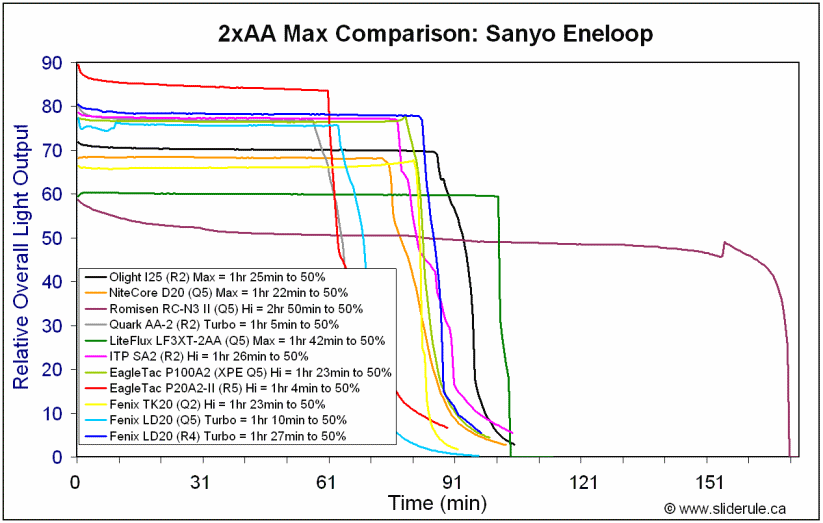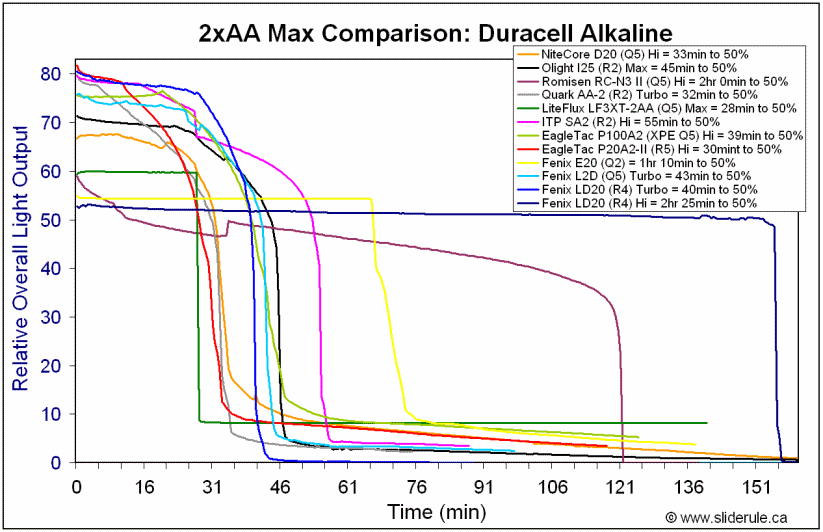I just realized that I'd chosen an 8-pack of rechargeable cells to be realistic about having spares on hand but didn't adjust the costing accordingly. With 8 cells you have 4 sets of 2 for use in a LD20, so instead of 1000 hours of light (from a conservative 250 charge cycle lifespan of the cell) you have 4000.
As a result the cost per hour of light drops significantly.
Likewise I messed up with the alkaline costs, forgetting to consider the cells as sets of 2. For equivalent runtime to match the light output of 8 rechargeable Eneloop cells we need in alkaline cells:
4000 / 2.5 hours = 1600
sets cells (Alkaline * 2 = 3200 cells)
3200 alkaline cells = 3200/32 pack (Amazon link was given) = 100 * 32 packs @ 22.59 each = $2259.00
Cost to recharge a cell has been
calculated as ~ 0.2 cents to recharge an eneloop and I've seen somewhere an actual power consumption measurement done that appeared to back this low figure up. Still let's take the worst case and call it a penny per charge, so we add 8 * 250 (charge cycles) * 0.01 = $20.00 (or perhaps as low as 8 * 250 * 0.002 = $4.00), bringing our rechargeable costs from $80.14 to either $100.14 or $84.14.
Putting the costs into full perspective:
Rechargeable cells:
$84.14 / 4000 hours of light = $0.02 per hour.
$100.14 / 4000 hours of light = $0.03 per hour.
Alkaline cells:
$2259.00 / 4000 hours of light = $0.56 per hour
That adds up to
$1.41 to run the LD20 on "high" (not turbo) for two and a half hours
if using alkaline cells, at which time the cells are spent and need to be recycled. That same runtime, with all costs in and amortized over 4000 hours of use, will
cost something less than 6 cents to run the light for two and a half hours using rechargeable cells.
Clearly not everyone will use their AA powered light so heavily, so if usage is infrequent, disposable primary cells might be the right answer. Yet even the light-duty light user, if a reliable but inexpensive charger that meets the person's needs can be found, might reach a satisfactory cost-benefit tipping point that favours rechargeable cells sooner than later.
Comparing the cost of cells alone reach break-even fairly quickly:
8 pack eneloop @ 23.14 = $2.89 per cell
32 pack Duracell alkaline @ 22.59 = $0.71 per cell
Break-even point: 2.89/.71 = ~
4 recharge cycles before your eneloops become almost "free" as compared to disposable alkaline cells.
Many of us have quite a few devices that are powered by AA and AAA cells so chances are the cost of a half decent charger can be fairly cheaply allocated across the different uses.
Of course if you are going through 3200 alkaline cells chances are somewhere along the line you will have a leaker, so factor in the cost of a new light too. That many cells also weighs quite a bit, which may result in a back muscle spasm that needs treatment, so factor that cost in too!
E&OE
(Errors and Omissions Expected)



